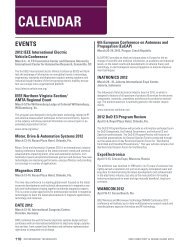2011 EMC Directory & Design Guide - Interference Technology
2011 EMC Directory & Design Guide - Interference Technology
2011 EMC Directory & Design Guide - Interference Technology
Create successful ePaper yourself
Turn your PDF publications into a flip-book with our unique Google optimized e-Paper software.
testing & test equipment<br />
on specific device type rather than general usage. This makes<br />
the mapping of well-understood methods of device assessment<br />
here (FCC) against there (MIC) quite, er, challenging.<br />
A private sector organization and CB in Japan (DSP<br />
Research: http://www.dspr.co.jp/) has developed an Englishlanguage<br />
database that eases this issue. Still, it would be<br />
useful to understand a bit of kanji.<br />
Note that there are similarities under both regimens for<br />
how non-licensed and licensed devices are handled. Nonlicensed<br />
equipment (such as low power devices, cordless<br />
phones and the like) can be placed on the market without secondary<br />
licensing. Cellular phones, on the other hand, must<br />
have a “blanket license” that applies to the system operator;<br />
this is not unlike the U.S., where cell phones are licensed to<br />
the operator and the process is transparent to the end-user.<br />
One of the requirements of the MRA is to demonstrate<br />
that a Conformity Assessment Body is approved to a scope<br />
that is equal to or greater than the requirements outlined in<br />
the MIC regulations. This bit of cross-referencing requires a<br />
deep dive into the methods for the devices, sorting through<br />
the technical requirements and demonstrating “competency<br />
by association.”<br />
I WAnt my radio certified. Where to begin?<br />
For any type of produce certification, one asks the same questions:<br />
What Provisions? What Requirements? What Limits?<br />
© 2008 Radiometrics Midwest Corp.<br />
• A2LA Accredited<br />
• “CE” Mark Testing<br />
• 200 Volts per meter<br />
• NARTE certified EMI engineers<br />
• Full service engineering support<br />
• FULL VEHICLE ANECHOIC CHAMBER<br />
• DOC, FDA, FCC, RTCA, MIL-STD, SAE testing<br />
(815)293-0772 www.radiomet.com<br />
Wir e l e s s A p p r o va l s f o r Ja pa n<br />
Any roadmap to certify a radio to Japanese law includes<br />
three main documents, starting with the Radio Law (Law<br />
No. 131 of May 2, 1950, as amended) which says that radios<br />
of a certain type (Specified Radio Equipment) must be certified.<br />
The Radio Law covers the usual administration and<br />
authority requirements, as well as spelling out a path for<br />
certifying equipment and operators. Other various topics<br />
include operation of coast guard stations and aeronautical<br />
stations and there are chapters on lawsuits and penal provisions.<br />
(Note that Terminal Equipment is covered by the<br />
Telecommunications Business Law—Law No. 86 Dec. 25,<br />
1984, as amended. In short, the approval process is similar<br />
for wireless and wireless telephony.)<br />
Article 38-2 of the Radio Law covers the requirements<br />
for Certification Bodies, to wit “…a person who wishes to<br />
conduct the business of certifying such radio equipment’s<br />
conformity with the technical regulations specified in the<br />
preceding Chapter may obtain registration from the Minister…[The<br />
Radio Law includes, by the way, requirements<br />
for maintaining decency and decorum on the air. George<br />
Carlin would certainly balk:<br />
“Article 108: Any person who transmits a message with<br />
indecent contents by means of radio equipment or communications<br />
equipment under Article 100 paragraph (1) item<br />
(i) shall be guilty of an offense and liable to imprisonment<br />
with work for a period not exceeding two years or to a fine<br />
not exceeding one million yen.”<br />
Note that this is not your ordinary imprisonment, it is<br />
imprisonment with work—breaking rocks. This is where<br />
they get all the nice stone for their Zen gardens.]<br />
Chapter 3 of the Radio Law is specific to radio equipment<br />
and this is where we dig into the details and how, ultimately,<br />
the MRA provides the bridge between the U.S. certification<br />
bodies (more properly: Conformity Assessment Bodies) and<br />
wireless certifications for Japan. NIST is now actively in<br />
the process of approving CABs for this process. As stated<br />
before, the private sector has existing capacity (under the<br />
APEC Tel MRA and the Japan-EU MRA).<br />
To get an approval, one must generate a report and demonstrate<br />
conformance (and submit to a Certification Body).<br />
To determine what data must be collected, it is necessary to<br />
refer to the ordnances that cover the specified equipment,<br />
notably the “Ordinance concerning Technical Regulations<br />
Conformity Certification of Specified Radio Equipment (aka<br />
Ordinance of the Ministry of Posts and Telecommunications<br />
No. 37, 1981).” This document lays out the various types<br />
of equipment and what data are to be collected and what<br />
instrument is used to collect the data.<br />
Table No. 1 (which covers eight pages) breaks down the<br />
action in a paragraph-by-paragraph cross-reference dependent<br />
on device function, providing the general quantity<br />
to be measured—“Frequency” and “Occupied Frequency<br />
Bandwidth”—and the type of instrumentation necessary.<br />
A fragment is shown in Figure 3 for illustrative purposes.<br />
By way of example, Article 2 (Specific Radio Equipment,<br />
etc.) calls out the frequency allocation and power limits for<br />
marine mobile equipment as follows:<br />
26 interference technology emc <strong>Directory</strong> & design guide <strong>2011</strong>


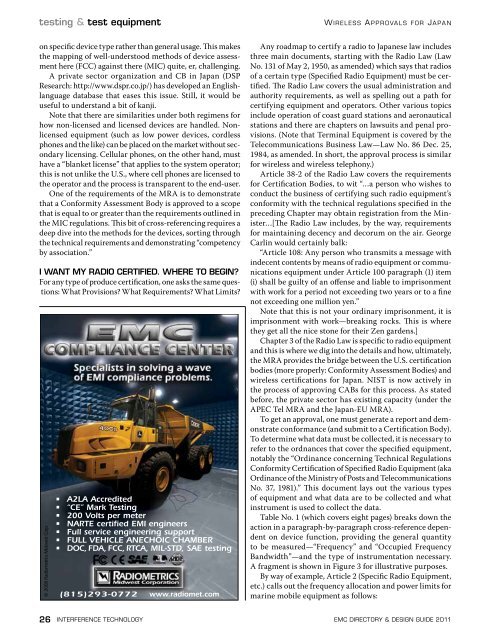

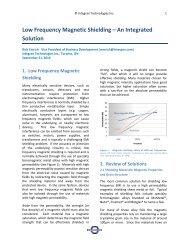

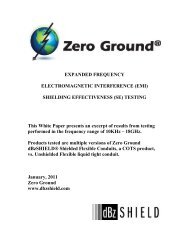
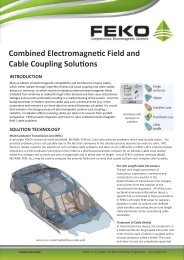

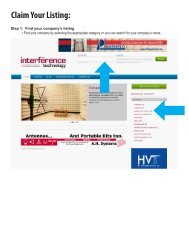

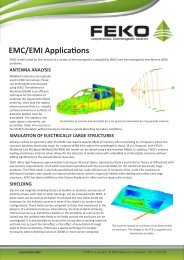
![[ thursday ] morning sessions 8:30 am-noon - Interference Technology](https://img.yumpu.com/23176841/1/190x247/-thursday-morning-sessions-830-am-noon-interference-technology.jpg?quality=85)
